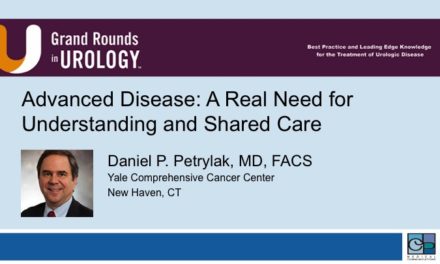Dr. Matt T. Rosenberg presented “The Role of PCP in Prostate Cancer Screening 2017″at the 27th annual International Prostate Cancer Update meeting on Friday, January 27, 2016.
Keywords: prostate cancer, PSA, screening
How to cite: Rosenberg, Matt T. “The Role of PCP in Prostate Cancer Screening 2017” Grand Rounds in Urology. January 27, 2017. Accessed Apr 2025. https://grandroundsinurology.com/role-pcp-prostate-cancer-screening-2017/.
Transcript
The Role of PCP in Prostate Cancer Screening 2017
Yesterday we had a meeting together. What we wanted to do was pound out what to do for the future for screening. And so what I’m going to be proposing is kind of a new idea, and I’m hoping to get some feedback from the group.
So what is the role of primary care in prostate cancer screening? And for us to understand that role we have to go back historically. And this is a slide I showed a couple of years at the meeting. This is a critical look at what’s going on. The patient comes in, talks to the doctor, gets an evaluation, gets a DRE, a PSA, eventually they get a biopsy, the biopsy goes to the specimen, that is the flow of the screening toward the treatment of prostate cancer. The problem is that we know this from the PSA to the biopsy there’s been way, way too many problems. It’s too subjective. We do too many unnecessary procedures, and why is that. And this goes back to something we know, that the PSA itself is all over the place. And for a primary care doc listening to my colleagues in urology, whether it’s 2.5, or 4.0, what’s the velocity, what’s the density? And the whole time I’m thinking we’re creating way too many unnecessary patients. And we know it’s an imperfect test. We know that we have a high false positive rate, we know we do too many biopsies, we know that a lot of biopsies end up with no disease, and we know we create unnecessary patients. We found this out with mass screening, the European study, the American study showing over diagnosis, leading to overtreatment, overtreatment leading to economic loss and side effects. And when you put all this into the meat grinder, when you put the patient complications and the poor consensus on PSA and the unnecessary procedures, the meat grinder shows us we’re not going to screen them. And that’s where we’re at in 2017.
So we see the end, the death of PSA. And this may be a little dramatic, but this is what is coming out in primary care. And you see this in the literature. Every week I get an email from Medscape announcing another study, this one, “Early Prostate Cancer Cases Drop as PSA Screening Declines.” We see that, we’re concerned about it, but this is not the end. The end is this, patients are dying. Patients are dying because we’re missing an opportunity to screen, because in primary care we’re told it is a bad thing to do.
So a couple of years ago we came up with an algorithm. And the algorithm is an attempt of cleaning this up. You take the healthy patient, you screen them with a PSA. If the PSA is less than 1.5 you’re good to go, we’ll see you in a couple of years. If it’s 1.5 or greater then we’re saying you should evaluate the patient, either the primary care or the urologist should evaluate that patient using a biomarker, 4K, Phi, PCA3, SelectMDx. If they’re low risk we’re good to go, you follow them up in a year, if they’re high risk we consider for a biopsy.
So, let’s look at this a little bit more critically. Why do we get 1.5? The reason we’re looking at that is because that’s when the risk of prostate cancer starts to go up. We can very comfortably say that if a patient has a PSA of less 1.5 the risk of prostate cancer in their life is very low. When it’s 1.5 or more the risk starts to go up. And in fact, PSA of 1.5 is not that common. If you’re thinking that that doesn’t—1.5 is too low, the reality is it’s not very common at all. I did a study using some data from the BioReference Lab, 217,000 PSAs, only 27% were 1.5 or greater. And that means that those with 1.5 or greater, that 27% are the ones that we have to have that shared decision making process with.
The problem is we said let’s get a biomarker on those high-risk patients and then send them off for referral, consider a biopsy. And this was the mess, we inadvertently created a mess, because there’s no consensus among biomarkers right now. Phi, SelectMDx, 4K, PCA3, what do we do? What is high risk, who do we biopsy, are there head-to-head studies, and are they cost effective? And the answer to a lot of this is we don’t know, we’re still working through that.
Unfortunately, because of this, because of the confusion with the biomarkers what we’re seeing in primary care is some of us are starting to get them, I use them, my partners use them. Doctors I’ve lectured to all over the country are starting to use them. And I’m inundated with emails from people I’ve lectured to who said, “you know, I got a biomarker, I sent the patient to the urologist and the urologist said so what, so what.” I’ve heard responses of, “Sorry your 4K was 18%, go back to your primary care doctor, they shouldn’t have run that.” I’ve seen things of, “Oh, well we don’t know that—that’s too bad the biomarker is high. Why don’t you just get another PSA in three months?” Well, that’s not right either. I had one recently where they said, “Well, the nurse practitioner did a DRE. The DRE was normal so we’re ignoring the biomarker.” Now, that’s not right. And I’m not saying these decisions are wrong, I’m saying that we need a better consensus. Because when you put all this information into the meat grinder, like the PSA, the lack of consistency with biopsies, the poor consensus on biomarkers, the cost, we get confusion amongst primary care. They’re confused, we’re creating stress by doing more tests on patients, we’re wasting time and wasting money, as a result primary care is saying, no, we’re not going to do this. And this what I’m hearing universally, we’re not going to do this. And the fate of the biomarkers will be the same as the PSA unless we come to the plate. Somewhere along the way, actually right now, we need to come to the plate and come up with a consensus.
The fact of the matter is we need new guidelines. The guidelines we have now are terrible, across the board they’re terrible. We all disagree with United States Preventative Services Task Force, the American Academy of Family Practice, go along with those guidelines, we don’t like those. The American Urological Association (AUA) guidelines are difficult. They’re not easy to use. The National Comprehensive Cancer Network (NCCN) guidelines are not easy to use. The European Association of Urology (EAU) guidelines are easier to use, but they’re not as straightforward as we need them to be, so it’s a call to arms right now. We need to be able to screen the right patient, identify aggressive disease, and standardize the process. We need a consensus. You cannot live in a bubble as a urologist anymore. You need to understand that as primary care I screen a lot of diseases. And that is within the specialty of primary care.
So I’m going to challenge you with this, let’s start with the right patient. Let’s change the dictum. Forget the idea of screen at 40, screen at 45, screen at 50, you stop screening at 70 or 75. That’s what the guidelines are telling us, and that in and of itself is wrong. That’s wrong. That’s seeing the world from a specialist’s point of view and not from my point of view. I assess patients five days a week, eight hours a day. When you come in to see a family doctor, I am telling you if I think you’re healthy, I think you’re not healthy, what you need to do for that. And I actually can tell you if I think you’re going to live for a couple of years or not. So the screening patient should be the one who is healthy enough that I would treat an aggressive cancer if they had it. That’s what I need to determine. If you come into my office and I think you’re healthy enough that if knew you had aggressive you had prostate cancer that day I would treat it, which means yes, I would treat the 80-year-old who is coming to play tennis with his dad. I would not treat this 50-year-old who just a bilateral below the knee amputation (BKA) and is smoking through their trach tube. But understand, this my job, this is my specialty. I can pick that patient a heck of a lot better than you can. So if they’re not healthy enough I’m not going to do anything. If they are, let’s go to the DRE and PSA. Let’s start by recommending what’s normal. Now, if it’s an abnormal DRE I’m referring them. If the PSA is greater than 1.5, I’m referring them to a biomarker. That’s what I’m going to do, all right?
Now, please understand something if you’re questioning the biomarker, this is not my first rodeo. If I see a high blood sugar I don’t go oh my god, I have to call the endocrinologist, I get an A1C. If I see an abnormal thyroid I get a thyroid series, if I see an evaluated liver function test I get an ultrasound. So why would I not do this? So following a high PSA with a biomarker is a no-brainer and belongs in the office of primary care.
So the question I have for you, if we’re going to screen this, and this what I did with my consensus group yesterday, is there a level of the PSA that would make me not get a biomarker and immediately refer the patient to a urologist? Now, at our panel session maybe you can give me you’re your opinion, I think it’s 10. And I want you to think about it this way, if I have a PSA of 6, and I get a biomarker and the biomarker is low, what are you going to do? If the DRE is normal and the biomarker is low you’re not going to do anything. I can follow them. If it’s 8 what are you going to do? If it’s 10 what are you going to do? The bottom line is I can help you screen the appropriate patients, just like I do with other disease states.
Now, the problem we’re having, the problem I’m seeing with the guideline or the algorithm we initially published is that the biomarker interpretation is not consistent, and we need to make it consistent. So again, these are questions for the panel later, what level of a biomarker prompts a referral. And not why would you get a biopsy, but why wouldn’t you get a biopsy. I put the levels that the group said yesterday were the threshold levels for the biomarkers. So above these levels why wouldn’t you get a biopsy? And the reality is you should, only for limited reasons would you not.
You need to understand that we order 90% of the tests. But this is drastically reducing, or there’s a drastic reduction because of the guidelines, or the lack of guideline support. And we want to do the right thing. As I’ve lectured all over the country and I’ve asked my colleagues, would you want me to help you find that aggressive disease? They’re like absolutely. We don’t want to find all that disease that doesn’t mean anything, we want to find the right disease, but because we can’t do it we won’t screen. And then I tell them about biomarkers and our ability to do that, and they’re like why didn’t anyone tell us. My third year medical student, or resident this week who is going out in the real world in a few months didn’t know this existed. Clarity will make this easier, and please understand as urologists I seek guidance from you. You need a consensus to help me do the right thing.
So when we go back to the algorithm we need to change it. If that PSA is greater than 1.5 that’s my job. I’m going to evaluate that, I’m going to get the biomarker. This needs to be the new world. Not consider biopsy, as we see there, it’s refer for biopsy. Refer for biopsy, and don’t get the biopsy only under very specific reasons. So the future we need to embrace is this, I need to screen the patients who would benefit from intervention if they have the disease. It is appropriate and within my world to do the biomarker. We’re going to start this process, five years from now this should be the world that we have. The PCP, the primary care should only refer patients who are strong candidates for a biopsy. And finally, the only patients who should not be getting biopsies are the ones who see you in consultation for the biopsy, I have a change of heart with the risk/benefit analysis where they said no, I don’t want to do it, or you want an MRI.
ABOUT THE AUTHOR
Matt T. Rosenberg, MD, earned his medical degree at the University of California, Irvine, where he trained in general surgery. He also trained in urologic surgery at Brigham and Women’s Hospital in Boston before changing fields to general practice. Dr Rosenberg has a special interest in the medical management of urologic diseases and has authored or coauthored articles appearing in Urology, The Journal of Urology, BJU International, The International Journal of Clinical Practice, and other peer-reviewed journals. He now practices in Jackson, Michigan, serving as Medical Director of Mid-Michigan Health Centers, and on staff at Allegiance Health, where he served as Chief of the Department of Family Medicine from 2003 to 2006. Dr. Rosenberg is a Senior Editor at the International Journal of Clinical Practice and is Founder and Chairman of the Urologic Health Foundation, a nonprofit group dedicated to the education of primary care physicians in the field of genitourinary disease. In 2011, he was appointed by the AUA Office of Education to be the Coordinator of Primary Care Education.




